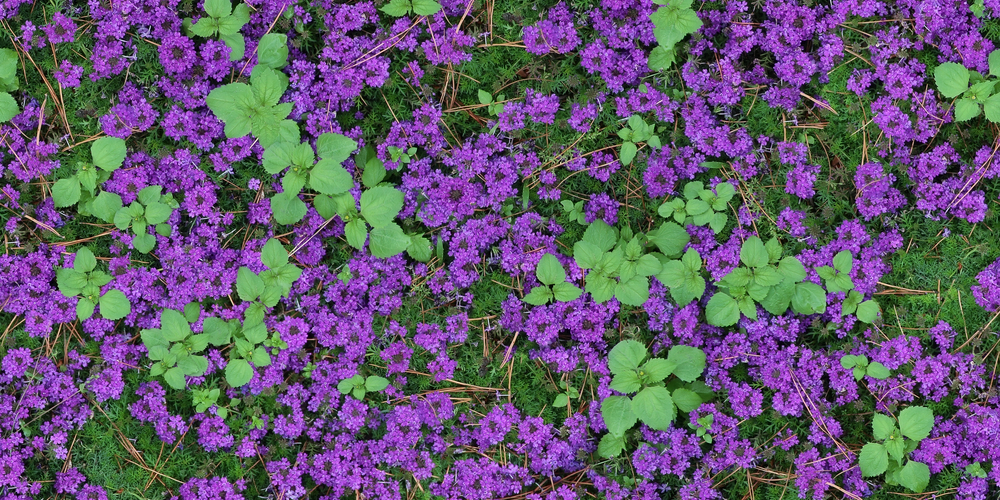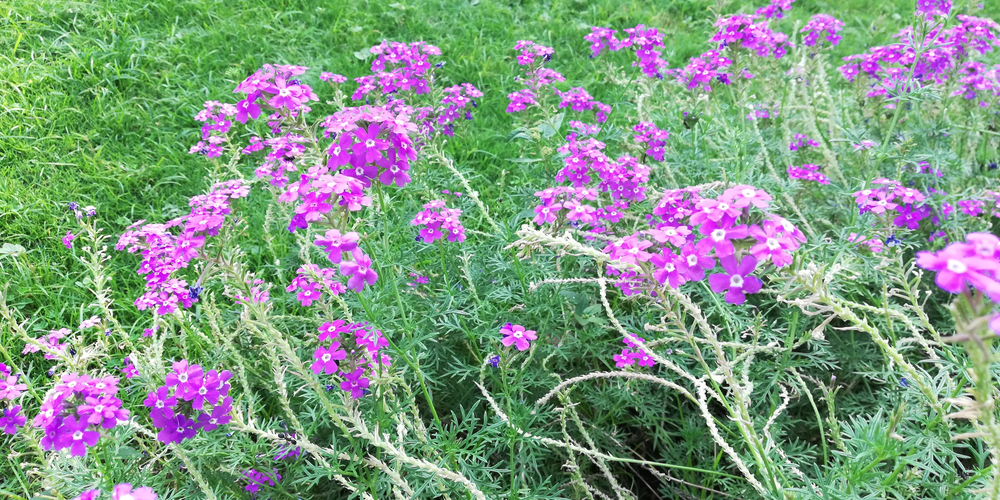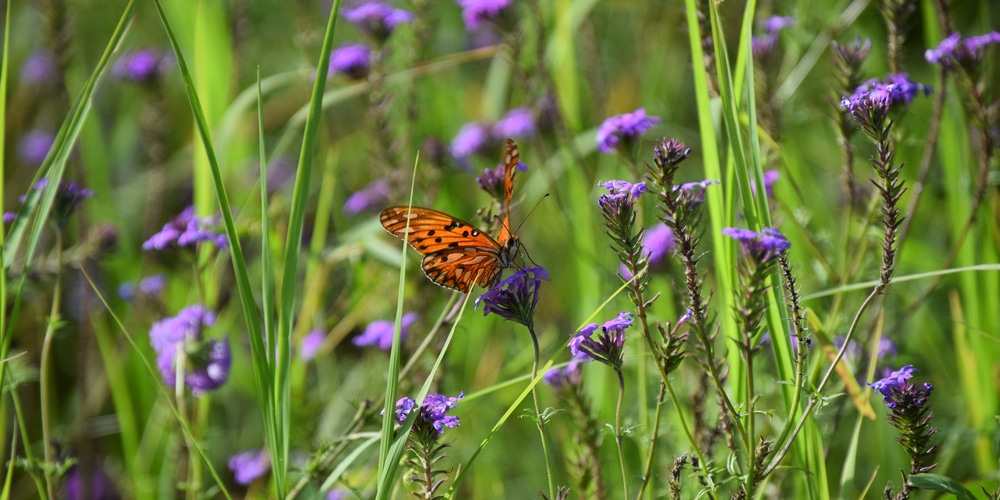Moss Verbena is a native, low-growing perennial that produces an abundance of small, lavender flowers from late spring. With its trailing habit and long bloom period, Moss Verbena is an excellent choice for cascading over walls or used as a groundcover. This heat and the drought-tolerant plant also attracts butterflies. Learn all you need to know about Moss Verbena care in this article!
| Botanical Name | Glandularia Canadensis |
| Common Name | Moss Verbena |
| Plant Type | Perennial |
| Flower Color | tubular purple flowers |
| Size When Mature | 24 inches |
| Bloom Time | Late Spring |
| Sun Requirements | Full but not direct sunlight |
| USDA Hardiness Zones | USDA 9-11 |
| Soil PH Range | 6.0-6.8 |
| Soil Type | Moist, slightly acidic |
| Water Needs | medium |
| Native Area | North America |
What you Need to Know About Moss Verbena
Moss verbena (Glandularia Canadensis) is a perennial wildflower that grows in moist areas such as meadows, stream banks, and wetlands. It has hairy, glandular leaves and produces spikes of tubular purple flowers from late spring to early summer.
The flowers last for only one day, but new ones bloom daily over a period of several weeks. Once the plant matures, it can reach up to 2 feet in height and has a spread of up to 3 feet.
This plant is native to North America and was once used medicinally by Native Americans. It is now a popular ornamental plant and is often used in butterfly gardens.
As an easy-to-grow plant that tolerates various growing conditions, moss verbena is a good choice for gardeners. It can be grown in full sun or partial shade and prefers moist soil but can also tolerate dry conditions.
The flowers are highly fragrant and are often used in dried arrangements. The foliage of moss verbena is also attractive, with its silver undersides and hairy leaves.
How to Care for Moss Verbena
Moss Verbena is a beautiful plant that is often used in landscaping. It can be found in shady areas such as under trees, or it can be grown indoors if you have the right conditions. As with any other houseplant, moss verbena care needs to be taken into consideration when caring for your plants. Below are some tips on how to care for moss verbena.
Light
This plant does best in bright, indirect sunlight. If you are growing it indoors, place it near a window where it will receive plenty of light without being in direct sunlight. Direct sunlight can scorch the leaves of the plant and cause them to turn brown.
Since moss verbena prefers bright light, it is important to rotate the plant regularly, so all of the leaves have a chance to receive adequate light.
Water and Soil Needs
Moss verbena needs regular watering, but do not water it excessively. The soil should be kept moist but not wet. If the soil is too wet, the plant could develop root rot.
This plant grows best in slightly acidic soil with a pH of 6.0 to 6.8. You can test the pH of your soil with a pH meter or soil testing kit. If your soil is not acidic enough, you can add sulfur to the soil to make it more acidic.
Temperature Requirements
Moss verbena is a tropical plant and requires warm temperatures to thrive. It can tolerate some cooler temperatures, but it will not do well in cold weather. The ideal temperature range for this plant is 60 to 85 degrees Fahrenheit.
Moss verbena can be grown in USDA climate zones 9 to 11. In these zones, the average temperature is above 20 degrees Fahrenheit. If you live in a colder climate zone, you can still grow moss verbena, but you will need to provide it with some supplemental heat.
Fertilizer
This plant does not need a lot of fertilizer. In fact, too much fertilizer can actually damage the plant. Apply a balanced fertilizer to the soil around the plant once every two months during the growing season. The best fertilizer for this plant is a 10-10-10 fertilizer – 10% nitrogen, 10% phosphorus, and 10% potassium.
Common Diseases
Moss verbena is relatively resistant to diseases and pests. However, it can be susceptible to root rot if the soil is too wet. If you notice any of the leaves turning yellow or brown, this could be a sign of root rot. Remember to only water the plant when the soil is dry to the touch to avoid root rot.
Moss Verbena Propagation
Because of its popularity, moss verbena is available for purchase at most nurseries. However, you can also propagate moss verbena by division or stem cuttings.
Propagation by Division
To propagate by division, divide the rhizomes of the plant into sections and replant them in fresh soil. Remember to use a sharp knife or garden shears to avoid damaging the rhizomes.
This is often the preferred propagation method because it is less time-consuming than propagating by stem cuttings.
Once you have divided or planted the moss verbena, water them well and keep the soil moist until they become established. You’ll know your plant is well-established when it begins to produce new growth.
Propagation by Stem Cuttings
To propagate by stem cuttings, take a cutting from a healthy branch of the plant and place it in water or soil. The cutting should have at least two leaves and a small amount of stem. These leaves will provide the energy to help the cutting root.
It can take a few weeks for the cutting to start rooting, so be patient. Once the cutting has rooted, you can transplant it into a pot or garden bed.
Both of these methods of propagation are easy and can be done by most gardeners. If this is your first time, propagating moss verbena during the late winter or early spring is the best time to do so.
How to Prune Moss Verbena
Pruning moss verbena can be a little confusing for first-time gardeners. There are several different ways to prune this plant, and each method has its own benefits.
The most common way to prune moss verbena is to shear it back by half in the late winter or early spring. Shearing will help keep the plant from becoming too tall and leggy.
If you want to create a more bushy plant, you can prune it by pinching off the tips of the stems. This will encourage the plant to produce more lateral branches.
Pruning moss verbena can also be done to control its size and shape. If the plant becomes too large for its space, you can prune it back to keep it in bounds.
Remember, when pruning any plant, it is essential to use sharp tools and make clean cuts. This will help prevent disease and encourage new growth.
Moss Verbena Care: Final Thoughts
Moss verbena is a beautiful and versatile plant that can be used in various ways. It is easy to care for and can be propagated by division or stem cuttings. It is also resistant to diseases and pests.
With a little bit of TLC, moss verbena will thrive in your garden and provide you with years of enjoyment. So go ahead and add this beautiful plant to your garden today!
Related: Birds Foot Fern


